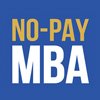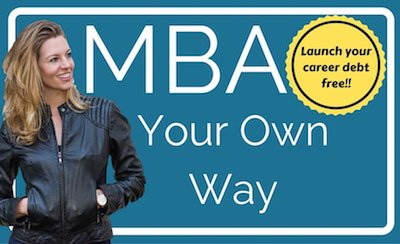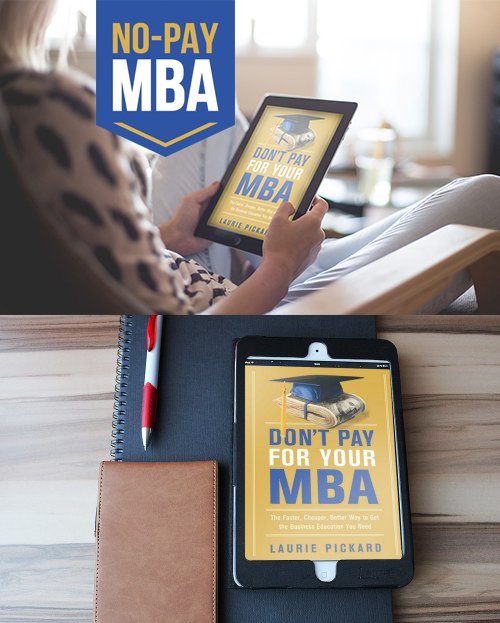by Laurie Pickard | Jan 17, 2016 | Career Development, MOOC MBA Design, Most popular posts

Here’s university education in a nutshell: First, the university deems me talented enough to succeed by putting me through an admissions process. Next, the university provides a series of hurdles for me to clear, primarily courses that I must complete. The courses are of varying levels of difficulty and quality, and I have a fair amount of choice over which courses I take, so my set of hurdles may be higher or lower than my classmates’, but no matter. After I complete the requirements the university has set out for me, it grants me a diploma and allows me to carry around the university’s brand name for the rest of my working life.
With the university’s stamp of approval, I am able to access higher quality and better paying jobs. Which is a pretty good thing because in exchange for this process, I have paid the university a pretty penny. I need a high-paying job in order to be able to pay off my students loans.
But what if higher education didn’t actually work like this at all? What if education were actually a transformation that occurred inside of the learner’s mind? What if professors were neither task masters nor the arbiters of my success but were rather guides in a process of transformation that I, the student, was ultimately in charge of? What if I could learn not just in the classroom but also in the real world? And what if everything I learned, no matter where I picked it up, could “count”? It sounds lovely, but of course there is a problem with this method of learning. Who will be there to attest to the change the learner has gone through?
In other words, if you direct your own education, how will future employers know that you’re qualified to hire?
This, of course, is exactly the situation at hand.

The credential problem
When I started the No-Pay MBA project, I set out to complete the equivalent of a two-year MBA program in three years of part-time study. I have used MOOCs and other free and low-cost online resources to complete this education. I based my course progression on the curricula of top-flight MBA programs. Now that I am nearing the end of my program - I expect to finish in May of 2016 - I have proven (at least to myself) that I am capable of learning what is taught in business school, even if I wasn’t willing to drop a hundred-fifty grand to do it. And I have indeed gone through an internal transformation. However, I am still left with what I have come to think of as “the credential problem.” Who will legitimize my transformation so that I can take it into the job market and be paid for it?
Ultimately, I would like for my business studies - and yours - to provide a direct pathway to increased employment prospects. But new survey data from the Graduate Management Admissions Council shows that we still have a ways to go toward that goal. Currently only 8% of recruiters in the US see MOOCs as a viable alternative to business school (other regions view MOOCs more favorably). I’ve thought about various solutions to this problem. Would a university grant me ‘credit’ for the courses I’ve taken? How much would they charge to do it? Would I be willing to pay $5,000 for that service? $10,000? Would I be willing to trade in my No-Pay MBA for a degree from a lower-tier university? Or would I hold out for a degree from a mid- or top-tier school? It seemed unlikely that the better business schools would go in for a scheme like this, and I wasn’t sure I was willing to pay even a modest sum for a lower-tier degree. I even thought briefly about creating my own credential, which I could grant to others who go through my program, but ultimately I rejected the idea. Quality control seemed much too difficult, and it seemed like a risky business overall.
The portfolio solution
The credential problem is not just my problem. Anyone who wants to leverage a MOOC-based education for career advancement faces the same issue.
Fortunately, there is a solution to the credential problem.
While MOOCs have gone on a wild roller coaster in the press, by turns hyped as the great disruptor and scoffed at as entertainment for the overeducated, a quieter revolution has been occurring in education. The serious thinkers seem to agree that the real disruptive potential rests with competency-based education, which emphasizes skills over seat-time or course completion.
Furthermore, while recruiters may be tepid towards MOOCs, fully 92% of employers say that proven ability to perform is critical to their selection of who to hire, more employers than for any other criterion.
Hence, I would like to present the portfolio solution to the credential problem. The portfolio solution says that you can legitimize what you’ve learned in MOOCs - or any other means - by demonstrating your competency, displaying what you can do for anyone who wants to know. By creating a portfolio, you can provide external evidence to anyone who wants to understand your education. No third-party validation, just direct observation of what you are able to do.
Core business competencies
When I first released the portfolio feature on No-Pay MBA, I didn’t yet have specific guidance to give about what to put in a portfolio. Having had some time to mull it over, here is my take on what a competency-based business education might look like. (Keep in mind that this is just a first draft.) Below is a list of the skills that I believe every business student should strive to master, along with some suggestions on how to display those skills in an educational portfolio.
Communications
Business professionals need to be able to express themselves in a variety of settings and through a variety of media, including oral presentations, written reports, and slide decks. You should be able to make a case for your point of view, giving a compelling argument that draws on concrete evidence. You should also be a good listener, able to understand the viewpoints of others.
Suggested portfolio pieces:
- Recording of a talk you have given,
- Slide deck you have produced,
- Article or blog post expressing an opinion.
Strategic Analysis
A business professional should be able to analyze the strategic position of an organization, understand market opportunities, and assess the potential of a new project or idea. Strategy brings together many disciplines, including finance, entrepreneurship, and marketing. Effective presentation of a strategic viewpoint also requires excellent communication skills.
Suggested portfolio pieces:
- Strategic analysis report,
- Business model canvas for an entrepreneurial idea.
Management and Leadership
Management and leadership are at the core of the MBA, yet they are the most difficult skills to demonstrate virtually. However, among our colleagues we all know who we want to have on our team. A business professional should be able to organize a team to produce a deliverable (project management), delegate and supervise the work of others (management), and be able to contribute to a team she is not leading (teamwork). She should also be able to conduct a negotiation on behalf of the organization she represents. One of the main functions of the No-Pay MBA Network is to provide opportunities to hone one’s management and leadership skills, including managing projects, facilitating teams, and conducting negotiations. We do this through facilitated group courses, team projects, and business simulation activities.
Suggested portfolio pieces:
- Narrative feedback from those you have supervised or from a team you have facilitated (available through the No-Pay MBA Network),
- Narrative assessment of a negotiation or feedback from a negotiation partner,
- Feedback from team members in a business project or simulation.
Financial and Quantitative Analysis
Business professionals need to be able to work with numbers. They must understand the key concepts and language of finance, and should be comfortable reading and interpreting financial statements. They should be able to build financial models, value projects and companies, and make recommendations regarding investment decisions. In today’s data-rich environment, it is also helpful to be able to extract insight from large datasets.
Suggested portfolio pieces:
- Financial model you have built,
- Valuation report for a project or company,
- Data analysis report.
Technology
While a business professional does not need to be a computer programmer, he does need to be able to use the technologies of the day. Coming out of a business program, a graduate should be comfortable with a wide variety of organization, communications, and productivity technologies. These include email, shared calendars, video-conferencing, messaging (e.g. Slack), file sharing, and project management softwares. Standard business software solutions such as spreadsheets, word processing, slide presentations, and database management should also be part of the repertoire. Above all, a business professional should be comfortable adopting and learning to use new technologies, given the rapid pace at which technology is changing and the impact technology has on all businesses.
Suggested portfolio pieces:
- Links to social media profiles,
- Implicit use of technology as demonstrated in other portfolio pieces.
by Laurie Pickard | Oct 2, 2015 | Career Development
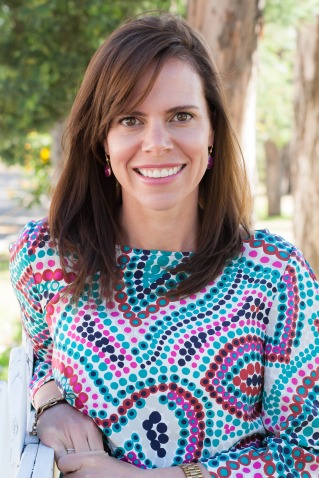
Anna Sparks
Earning an MBA-equivalent through self-study with MOOCs says a lot about you as a job candidate. It says that you are willing to do things creatively. It says that you aren’t confined by traditional ways. It shows that you can get things done even with limited finances. It shows that you are dedicated to finishing a project. These qualities are all incredibly important to most employers in the current market.
Your No-Pay MBA should absolutely be listed under Education on your resume, but don’t stop there! I want you to let this non-traditional experience shine, highlighting it in your cover letter or in a key qualifications section at the top of your resume.
Let’s explore some strategies for showcasing your No-Pay MBA - both on your resume and in your cover letter.
How to Include Your No Pay MBA on Your Resume
If you have not yet completed your coursework, check out these ideas for how to put a No-Pay MBA in-progress on your resume. Once you’ve completed your MOOC-based MBA, it absolutely belongs in your education section.
EDUCATION
Master’s in Business Administration (equivalent) 2015
Online Courses offered by University of Michigan, Wake Forest University, etc.
Let’s dissect this starting with the first line. It’s important to write “equivalent” because, like it or not, employers may ask for a copy of your degree and then you’ll be in a bit of a pickle. It’s also important to write what year you earned your degree (or finished your last class to complete the degree) so that it follows the same format as your other education and so that the employer understands how recently this happened.
If you have a hole in your resume, from taking time off from work for any reason, and during that time you completed all or part of your MOOC MBA, I suggest adding a date range (such as 2012 – 2015) to the end of each of your listings under education. This will show your employer that you weren’t sitting around unemployed, but you were working towards an advanced degree (or the equivalent).
The second line should list the universities where you took your classes. Try to list the universities where you took most of your classes. If it is a complete hodge-podge, name a few of the universities and then add “etc.” as I did in the example.
Don’t stop at the education section!
Because getting your MBA equivalent using MOOCs is still pretty innovative, it’s a good idea to present your MBA in another way instead of just writing it on your resume and letting your potential employer figure out what it means and if it’s important or not. Remember: it’s your job to tell them why it’s important. For those of you who are applying for jobs that require an MBA, this is going to be especially important. And, even if an MBA is not a requirement, you’ll want to take control of how the conversation goes. The best way to do that is to start the conversation yourself.
You’ve got two options here: 1) key qualifications section of your resume or 2) cover letter. Notice I said “or.” I wouldn’t mention your MBA in both spots because it would be overkill. Choose the option that works for you.

Make a good first impression in the key qualifications section
A key qualifications section is your best friend if you have done anything non-traditional in your career, including working in something wildly outside of your field, taking more than a year off of your career or, in your case, pursing a non-traditional education.
A key qualifications section is a short paragraph (three to four sentences) that provides an introduction to the resume. If you have one, it should be the first section on your resume (before professional experience). This section is important because it gives you a chance to control the first impression of you as a job candidate. Most employers will not read your resume bullet by bullet. By putting a short paragraph at the beginning of your resume, you give them something quick to read that nonetheless gives a full picture of who you are.
For someone who has completed a MOOC MBA, her key qualifications section may look something like this:
Graphic designer with ten years of experience supervising a team of twenty designers and working on logos and websites for clients such as Temple University, the Arizona State Congress, and political candidates. Independently earned a completely free MBA equivalent through strategically planning a curriculum based on Stanford University’s MBA coursework. Wide network of contacts in the greater Phoenix/Tempe region.
Exactly what you write in your key qualifications section will depend on your own qualifications AND (don’t forget this part) what your potential employer is looking for. In this example, I chose to highlight this candidate’s experience working in the state of Arizona. However, if the candidate has moved to California, she is wasting space by highlighting her network of contacts in Phoenix. In that case, she should look at the job announcement (or better yet, talk to her contacts that work at that employer) to see what skills she has that will be appealing to her potential employer. Then, those are the skills she should highlight in her key qualifications section in order to catch their eye.
Give a longer explanation in the cover letter
If you don’t love the idea of including your MBA in the key qualifications section of your resume, you can include it in your cover letter. This option gives you a few extra lines, which may be a plus for some people. A good cover letter should have a clear intro paragraph, three paragraphs describing accomplishments or skills that your potential employer will be interested in, and a closing.
If you choose to mention your No-Pay MBA in your cover letter, make sure to mention it in the introduction. Then dedicate one of the three body paragraphs to explaining it. The reason it is so important to mention it in the intro is because your potential employer may not read the whole cover letter, but they are pretty likely to read the first and last paragraphs. You want to make sure they get the main points of your cover letter even if they don’t read it all the way through.
An example always helps:
Dear XXX,
I am writing to apply for XXX position. I will be able to make a significant contribution to XX organization because XXX. My prior experience dealing with difficult donors, successful efforts raising over one million dollars in my position with the Red Cross, and my creative problem solving skills as evidenced by my non-traditional MBA will all serve the American Cancer Society well as it enters into a period of rapid growth.
Paragraph 1: experience dealing with difficult donors with a great example.
Paragraph 2: raised over one million dollars in these creative ways.
Paragraph 3: (And this is the one you guys are really interested in so I’ll write it out completely.)
While working for the Red Cross, I realized that earning an MBA would not only enhance my fundraising abilities but also give me a better insight into the field that many of our most significant individual and corporate donors worked in. Although the Red Cross doesn’t provide funding for advanced degrees and I was not in a financial position to make an investment at that time, I didn’t let that stop me. I researched the MBA program at University of Michigan and decided to complete the relevant coursework, including a thesis, using online courses through Coursera. This non-traditional approach allowed me to complete the same coursework included in a traditional MBA and proved to me that lack of funding is never a reason to give up. The skills I learned from my non-traditional MBA helped me double the Red Cross’s fundraising dollars in 2014.
I look forward to talking more with you in an interview. Please feel free to contact me at XXX or XX@gmail.com.
Sincerely,
XXX XXXX
————-
Take these ideas and run with them! Because earning an MBA exclusively through MOOCs is such a new concept, it’s up to you to blaze the trail in terms of educating employers. Give these strategies a try and let us know how it goes!
Anna Sparks is a global career coach who helps professionals create attention-catching resumes and prepare for successful interviews. She works with people with international experience and those who need help fitting a unique job or educational experience into their resumes. She has lived and worked in six countries in Europe, North America, Africa, and Latin America in the last fifteen years. Anna currently lives in Quito, Ecuador. Get Anna’s free guides on How to Edit Your Resume Like a Pro and how to write The Best Cover Letter in 30 Minutes or Less over on her website.
by Laurie Pickard | Sep 20, 2015 | Career Development, Thoughts on Higher Ed and Life

Where are the women?
I’ve been taking massive open online courses and blogging on MOOC business education for over two years. In that time, I’ve followed the research on MOOCs with great interest.
One thing that I continue to find perplexing, and which comes up in all the stats on MOOCs, is that far fewer women enroll than men. It was reported last year that men were 71% of the general population of MOOC users. In computer science courses, the numbers were even more skewed, with women accounting for less than 20% of enrollment.
A few months ago, I started a business providing group learning and networking opportunities for MOOC business students, and this gender imbalance really hit home. When customers 1, 2, 3, 4, and 5 were men, I started to wonder what was going on. Finally some women began to sign up, but my clients are still far more likely to be male than female.
While many research papers and articles have noted the MOOC gender gap, I have not come across any that has sought to explain it. I don’t think it has to do with lack of interest in learning, and it certainly has nothing to do with ability to complete higher level coursework. In fact, on regular college campuses, women now outnumber men significantly (57% - 43%).
So I’m still scratching my head as to why fewer women than men are using MOOCs. And it’s really starting to bother me.
Women, MOOCs, and a career boost
As a woman who has used MOOCs for career advancement, not just to satisfy an intellectual curiosity (though MOOCs are good for that too), I believe that MOOC education can be particularly good for women. Which is why I find it troubling that so few women are taking advantage of the opportunities for career advancement that free online learning presents.
Here is why I believe MOOCs can be a boon to women looking to get ahead in their careers.
MOOCs build confidence
When I first started my project to get an MBA-equivalent using MOOCs, I remember feeling like I was playing catch-up. Part of the reason I wanted a business education was that it felt like everyone in the world know more about business than I did. I had the sense that everyone could read a balance sheet, that everyone know what acronyms like MVP and ROI stood for, that it was just me who didn’t have a solid grasp of business vocabulary.
As was reported in The Atlantic last year, this is an experience common to many women. The “confidence gap” leaves many women feeling like imposters at work, which in turn causes many women to shy away when it comes time to put themselves forward for promotion or other opportunities.
While men may be more likely to take risks at work, women can use MOOCs to build up their confidence before volunteering for a new assignment.Because MOOCs are so low stakes, they can prepare you to take risks in other professional or academic settings.
As I started taking business MOOCs, my confidence began to grow. I stopped feeling that I was lagging behind my colleagues in terms of my understanding of business. As I progressed in my coursework, I even began to see opportunities for my team to improve our operations based on the business concepts I was learning, and I became confident enough to propose new initiatives.
MOOCs allow you to try something new
The most popular MOOCs are in technical fields, such as computer science, programming, and data analysis. The gender gap in science, technology, engineering, and mathematics - the so-called STEM fields - is not unique to MOOCs. But the MOOC environment is actually the perfect place for women to try out something new. At the price of $0.00, the stakes couldn’t be lower.
Carolyn McIntyre, who now runs MoocLab.club, found a passion for coding through MOOC coursework. “Back then I had zero coding knowledge, had no idea what lay behind a web page and had never heard of the acronym MOOC,” she said. “ Now I live and breathe MOOCs and coding and I’m loving it!”
For women who have wondered if they might benefit from building a tech-based skill set, MOOCs are the perfect place to start.
MOOCs and work-life balance
The New York Times reported this year that a 24/7 work culture takes a heavy toll on women in particular. At the same time, women are more likely than men to use formal flexible working arrangements, while men are more likely to simply take the time they needed without asking for it. Perhaps a similar preference for formal agreements keeps women from exploring educational alternatives that have not yet been established as clear pathways to career advancement.
Given the fact that MOOCs are so much more flexible than traditional educational programs, they could be a huge boon to women (and men) seeking to preserve work-life balance while continuing to build skills.
For example, Nick Switzer, a medical device engineer from California, turned down the opportunity to get a formal business education at his company’s expense, opting instead for a MOOC-based business education. In large part, this decision was based on a desire to spend more time with his young children and to keep a more flexible schedule in the evenings.
Likewise, Hillary Strobel owns a media business and is taking MOOC courses to improve her knowledge of business. She finds that MOOCs allow her to work around her toddler’s schedule. Nap time guarantees her at least an hour to watch online lectures, though she may not know exactly when that hour will start. With MOOCs, that isn’t a problem.
How to get started
For women interested in exploring MOOCs as career enhancement, there are a lot of great resources to help you get started. The Washington Post published an article last week with some great tips. But the best thing to do is to simply log into one of the MOOC platforms - Coursera and edX are my favorites - and start browsing the course listings. You’re almost guaranteed to find something both piques your interest and has a direct application at work.
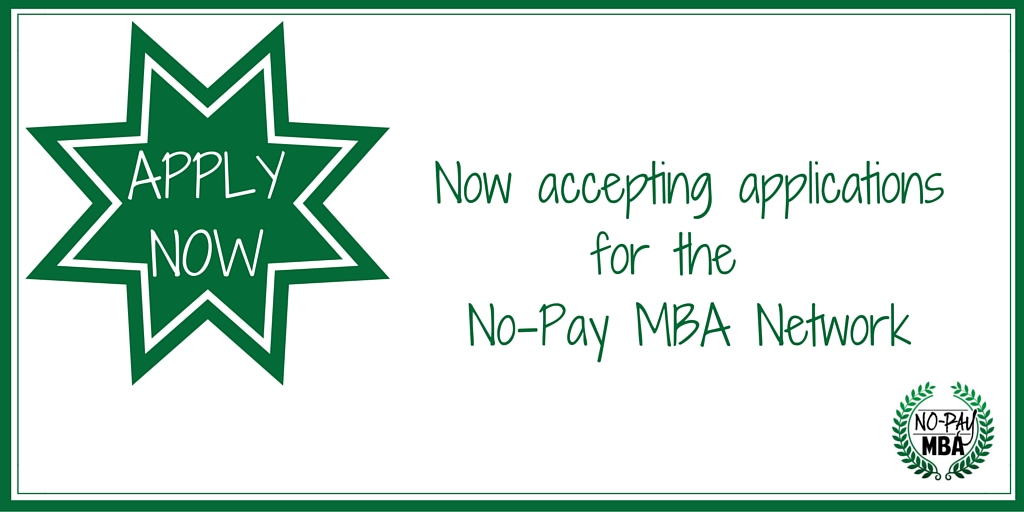
by Laurie Pickard | Aug 23, 2015 | Career Development, MOOC MBA Design, Most popular posts
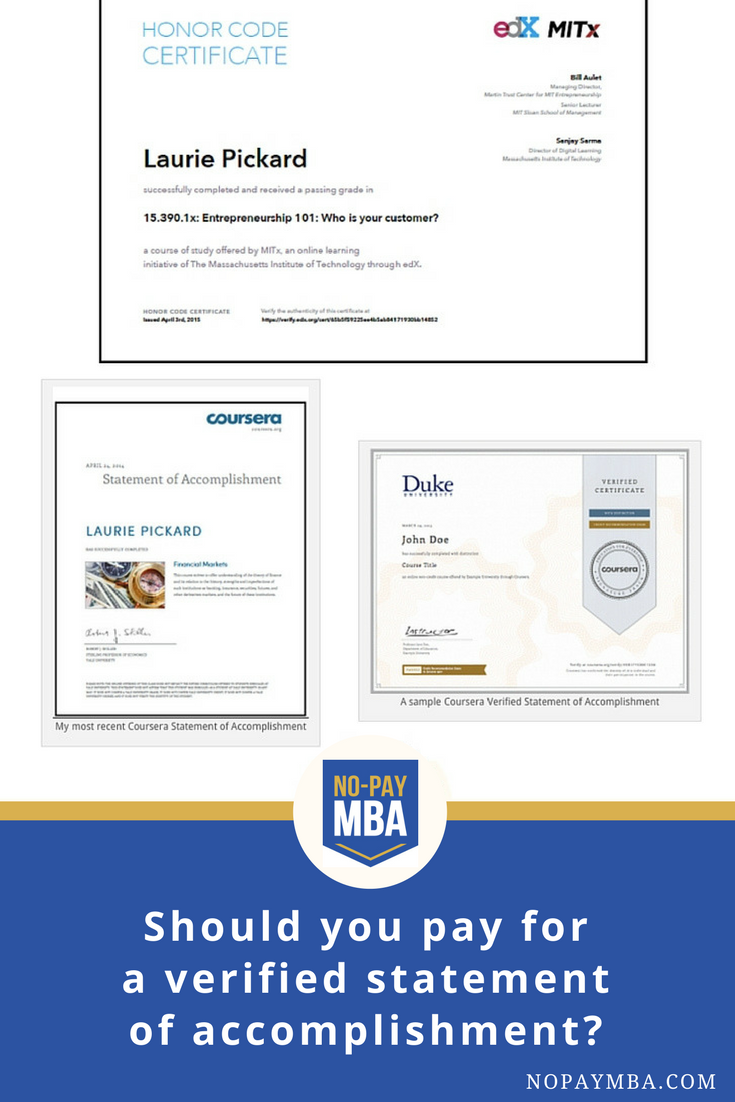
A lot has changed since I last wrote a post on whether you should pay for a verified certificate from a MOOC. If you’re just finding me now, my project is to use massive open online courses – MOOCs – to get an education equivalent to an MBA, at a fraction of the cost of a regular MBA degree. I don’t plan to receive any sort of credential for my studies, but I have sought to publicly demonstrate my efforts and my accomplishments, mainly through this website.
Back when I started my No-Pay MBA, all certificates were free. First Coursera and then edX introduced an identity-verified certificate for a fee, but these two major MOOC providers were still giving away honor-code certificates for free to anyone who completed all the requirements of their courses. At that time, I didn’t see much additional value for an identity-verified certificate over a non-identity verified one. So although I’ve taken over 25 MOOCs to date and have racked up a virtual stack of Statements of Accomplishment and Honor Code Certificates, I haven’t yet paid for a single one .
But things have changed in the world of MOOCs. Coursera is no longer offering free certificates in any of its courses. It’s $49 (or more) for an identity-verified certificate, or no certificate at all. EdX is moving in a similar direction, though in some of their courses it is still possible to get a free Honor Code Certificate. I’m a huge fan of MOOCs and MOOC providers; they’re providing an incredibly valuable service to learners all over the world. Charging for proof that you completed a course seems a smart move on their part. But it does pose a challenge for people like me.
I’ve set my benchmark at $1000 for a complete MBA education. If you’re going to start paying for certificates for every course, the $1000 MBA education becomes untenable pretty quickly. While I’ve called my project the No-Pay MBA, I’m not at all opposed to paying for elements of the world-class education I’m getting. I am, however, very discerning about how to allocate my scarce resources. If you’re taking an entire degree’s worth of courses and you start paying for certs at $50 a pop, (up to $100 for some courses), before long you’re looking at some serious cash. There is a lot I could do with $4,000, and I’m not sure that spending that money on course certificates is the best use of my money.
Last time I posted on this topic, my contention was that employers and most other people you’d want to present with your MOOC-based studies wouldn’t know the difference between the two kinds of certificates. I stand by that assertion, since I imagine it’s unclear even for many MOOC students.
Let me break it down for you. To receive an identify-verified certificate (which is what both Coursera and edX are selling in their courses), in addition to paying for the certificate the student has to prove their identify on each login to the system. This is done using photos taken by webcam and matched to a government-issued ID. Students also log a typing pattern, for subsequent verification.
As I’ve said before, I’m not sure any employers would dig deep enough to know or care about the difference between verified and non-verified certificates. However, if you claim to have taken courses that make you a more valuable employee, they may very well want to see some sort of proof. Regardless of who you’re hoping to impress, I do see some value in having a certificate to hang on your virtual wall, whether that wall is your LinkedIn profile, your resume, or your portfolio here on No-Pay MBA.
So what should you do?
Here is my updated advice for MOOC students in the brave new world of no free certificates.
Get certificates for some, but not all of your courses
If you’re only planning to take a few courses, you may want to get certificates for all of them. But if you’re taking many courses, be selective and choose just a few courses for which you’ll seek certificates. People’s eyes tend to glaze over after looking at about 5 certificates. Once you’ve demonstrated with a small number of certificates that you are capable of succeeding in online courses, you can more easily make the case that you’ve completed other valuable course work for which you didn’t seek certification.
Think in terms of skill sets
Rather than acquiring a random set of certificates for courses that bear no relationship to one another, use your certificates to demonstrate mastery of a skill set. Five intro-level certificates on different subjects are far less impressive than certificates for a series of five courses that build towards mastery. You might want to rely on specializations or series put together by the MOOC providers, or design your own course series.
Pair certificates with work examples in your portfolio
A powerful way to boost the value of any single certificate is to present the certificate alongside examples of the work you have done as a result of your coursework. Increasingly, portfolios are valued more highly than resumes. When you present evidence of your abilities next to your certificates, you make a compelling case that your education means something. The portfolio feature on No-Pay MBA is set up this way for a reason! Choose certificates that you can back up with a tangible project, whether or not you complete the project as part of the course itself.

Use loss aversion to your advantage
People who purchase certificates tend to finish their courses at a much higher rate than those who don’t. There are many reasons why this might be the case; perhaps those people who paid for certificates were more motivated or committed to the course to begin with. But there is also a robust literature in psychology to suggest that people don’t like to pay for something and then not get full value from it, whether or not there is any chance for the money to be refunded. Anecdotally, many MOOC students have commented on this blog that paying for certificates helps keep them motivated. Therefore, if there is a course you really want to take but are worried you might have difficulty finishing, that is precisely the course certificate you should be paying for.
Explore alternative payment arrangements
Coursera offers financial aid to students who make a compelling case that they need help to pay for their courses. Another strategy is to approach your current employer to find out if they would be willing to provide training to you in MOOC form. Fifty or $100 is not a lot of cash when compared to other methods of employee training. Your employer may also be impressed by your initiative, especially if you can tie your proposed course of study to tangible outcomes that benefit the company.
My last blog post on this topic generated a lot of discussion about the value of certificates. If you’ve been following the conversation, or if you’re new on this site, let’s hear your take. Do you pay for verified MOOC certificates?
by Laurie Pickard | Jun 24, 2015 | Career Development, Thoughts on Higher Ed and Life
This month the Lumina Foundation launched a national dialogue focused on transforming the credentialing system for higher education in the US. Here is my contribution to that discussion. I encourage readers to comment on this post or to add their voices to the discussion started by the Lumina Foundation.

Recently a reader of my blog sent me a link to a forum where a fascinating debate was taking place, spurred by the news that Coursera is phasing out its free Statements of Accomplishment for people who complete MOOCs. This debate crystallized around the question of whether credentials - not just MOOC credentials, but credentials in general - were worth anything.
“Portfolio trumps certificate,” says one contributor.
“Not in my country,” says another. “If you don’t have a certificate, good luck going through HR.”
“This is what’s wrong with employment,” a third chimes in. “I say this as a teacher who offers degree classes. You can earn a certificate without learning a damn thing.”
The discussion goes on at some length, but you get the idea.
So which is it? We all know that credentials (degrees in particular) are an absolute requirement to get certain jobs. But do they have to be? Can a portfolio ever win out over a credential? And what happens when Coursera completely gets rid of Statements of Accomplishment? Will MOOC students be obliged to pay for verified certificates in order for the courses to “count”?
How credentials work
Here at No-Pay MBA, we start from the premise that education has real value even when it it isn’t credentialed. In this article, I’ll explore credentials - what they are, what role they play in the marketplace, and whether it might possible to capture value from non-credentialed education.
To get started, let’s talk about the different types of credentials and look at how they function in the job market. I find it helpful to start by dividing credentials into two broad categories - degrees and all other credentials. I’ve heard David Blake, the CEO of Degreed refer to these categories as horizontal and vertical credentials. According to Blake, degrees are horizontal credentials; they level you up to a whole new category of job opportunities, lifting the floor underneath you.
Vertical credentials can be added on top of horizontal credentials, but they can’t be aggregated up to a horizontal credential at the next level. Most professional training courses fall into this category. Many fields recognize some type of non-degree credentials, but unlike degrees, these credentials are not generally understood outside of their field. Often if a non-degree credential is required, it must come with a degree, in the way that a teacher needs both a bachelor’s degree and a teaching certificate.
Are MOOCs just Sesame Street for adults?
 So what are MOOC course certificates, and what could or should they be? Should students be able to use them to build up to a horizontal credential like a degree? Or are MOOC certificates better understood as vertical credentials that are only valuable when stacked on top of a degree? Or maybe they’re neither - maybe MOOCs are best understood as edu-tainment, Sesame Street for knowledge-hungry adults. In which case, who cares if they come with any kind of credential at all?!
So what are MOOC course certificates, and what could or should they be? Should students be able to use them to build up to a horizontal credential like a degree? Or are MOOC certificates better understood as vertical credentials that are only valuable when stacked on top of a degree? Or maybe they’re neither - maybe MOOCs are best understood as edu-tainment, Sesame Street for knowledge-hungry adults. In which case, who cares if they come with any kind of credential at all?!
We can think about the possibilities for MOOC credentialing along a continuum. At one end of the spectrum, MOOCs are “just for fun,” personal edification that shouldn’t be taken seriously as professional training. There are plenty of people who will tell you that MOOCs are education for education’s sake, and that it’s impossible to capture any real value from them (in the form of a salary increase, for example).
At the next step along the continuum, MOOCs might be converted into more standard credentials. EdX’s partnership with Arizona State University is an example of this kind of arrangement; students can now take their entire first year of coursework at ASU via MOOC. After finishing the coursework, the MOOC certificates can be converted for credit at ASU. The same people who are saying that MOOCs are not capable of producing meaningful educational outcomes pooh-pooh such schemes as “credit laundering.”
At No-Pay MBA, we are at the opposite end of the spectrum. We believe it is possible to leverage a MOOC education for tangible career advancement, with or without a credential. And we think it’s only a matter of time before employers realize how valuable MOOCs can be. (In fact, they are already starting to.)
“If you don’t have a certificate, good luck going through HR.”
One big change that could bring efficiency into the hiring process would be the removal of the gatekeeping function of credentials that aren’t directly relevant to the jobs they keep people out of. The credential isn’t typically the only, or even the most important factor that determines whether you get a job, but as we all know, the lack of a credential can prevent you from getting one. But does it have to be this way?
I’m not opposed to degrees by any means; I have two of them, and I value them both, as well as the education they represent. But I do find it rather silly that HR requires a master’s degree - any master’s degree - for my current job, even though my master’s program in geography has very little relevance to my day-to-day work.
Here’s another thing I find a bit nonsensical about the way horizontal credentials work. Most people get their degrees fairly early in their careers and have finished their formal higher education before they are even 10 years into a work life that may span four decades.
The credential that you earn at age 22 or 25 doesn’t signal that you are at the top of your field, but rather that you are prepared to begin working in that field. Very often, the credential whose absence can keep someone out of a job doesn’t even signal work readiness for a particular field but instead serves as a signal of general competence. (Art history majors, anyone? Geography majors, for that matter?) And yet, even 15 years into a career, not having a degree or not having the right degree can still mean that you aren’t able to get a job that you are capable of doing.
One of the exciting things about MOOC education is that it is laying bare some of the contradictions in credentialed education. Why should it be necessary to have a degree just for the sake of having a degree, if there are other ways to get an education? If you can do the work, why should the credential you hold matter at all?
If the only reason to have a degree is because HR said so (not a very good reason), then it might be possible for MOOCs and other non-credentialed education to offer other pathways to employment. The company that finds alternative ways to select candidates for work readiness stands to clean up in the talent market.
Multiple pathways from education to employment
Of course, I don’t think HR policies are going to change tomorrow. But I do think it is possible for people who already hold degrees to demand that their efforts at continuing education be taken seriously. Let me start: I have a master’s degree, and I am telling you that my business education, which is entirely MOOC-based, is more relevant, useful, and applicable, than either of my degrees when it comes to preparing me for the work that I do. And I can back up that claim with a portfolio that shows how I’ve put my education into practice. (I’ll be publishing it on this website very soon.) Can I get you (employer) to trust me when I say that I have a business education equivalent to an MBA? I believe that I can.
I imagine a future in which there are multiple pathways from education to employment. The traditional, degree-based pathway remains. But non-credentialed educational pathways are also available, when backed up by strong portfolios. As a middle ground, competency-based programs can credential learning that takes place outside of traditional universities.
Wouldn’t many people benefit from this kind of flexibility? I know I have.
by Laurie Pickard | May 30, 2015 | Career Development

It’s hard to believe it’s been almost two years since I started the No-Pay MBA project and wrote the first words on this blog. When I started this project, my goal was simply to answer the question, “Would it be possible to create my own MBA using free online courses and other cheap or free materials?” I set up a website to document my studies and a blog focused on answering that question.
During the past two years, my thinking about online education has evolved just as much as my thinking about business has. First, I was able to answer that original question of whether it is possible to get a great business education – an MBA equivalent – using free online resources. The answer is a resounding yes! Second, I discovered just how many people are interested in low-cost, accessible business education. There are thousands of us around the world.
With these two realizations the focus of the No-Pay MBA website shifted from documenting and legitimizing my own studies to serving as a resource to other people seeking to get a business education without having to spend their life savings.
Now, I’m coming full circle. June 2015 marks a critical transition for No-Pay MBA. Over the course of this month, No-Pay MBA will go from a blog site to a web-based business.
No-Pay MBA’s mission is to provide information, advice, and support to help you get a great business education, equivalent to an MBA, based on the content that is freely available on the web. In launching a business, my hope is that No-Pay MBA can provide more and better services to a greater number of people.
I can’t wait to start watching this community grow and to see what you will contribute to it.
Through my own studies, I’ve discovered that a true business education must be a social experience; you can’t get the equivalent of an MBA just by taking courses. A business education involves getting out of the classroom, building a network, presenting yourself with confidence, and learning how to cooperate and negotiate.
That’s why in addition to providing a general framework for studying business via MOOC and advice on how to craft your personal business education, I aim to create a community where you can experience the social benefits that come with a traditional university education.
For me, that community is the most valuable thing that No-Pay MBA has to offer. I’ve tried to launch as quickly as humanly possible in large part because I can’t wait to start watching this community grow and to see what you will contribute to it.
I’m planning a lot of exciting activities throughout the month, both to mark the transition from blog to business and to make sure I answer all of your questions in the lead-up to launch. These activities will also include chances to meet and interact with your peers, people from all over the world who are considering or have already started No-Pay MBAs. You can stay informed about everything that’s coming by pre-registering to start your No-Pay MBA if you haven’t done so already.



